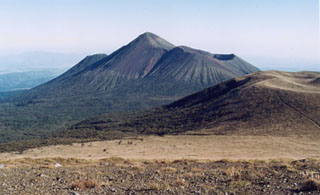Report on Kirishimayama (Japan) — 25 June-1 July 2025
Smithsonian Institution / US Geological Survey
Weekly Volcanic Activity Report, 25 June-1 July 2025
Managing Editor: Sally Sennert.
Please cite this report as:
Global Volcanism Program, 2025. Report on Kirishimayama (Japan) (Sennert, S, ed.). Weekly Volcanic Activity Report, 25 June-1 July 2025. Smithsonian Institution and US Geological Survey.
Kirishimayama
Japan
31.934°N, 130.862°E; summit elev. 1700 m
All times are local (unless otherwise noted)
The Japan Meteorological Agency (JMA) reported that eruptive activity continued at Shinmoedake (Shinmoe peak, a stratovolcano of the Kirishimayama volcano group) at least through 30 June. After the eruption on 22 June no further eruptive events were detected in monitoring data during 23-24 June, and weather clouds often obscured views. On 24 June white plumes rose more than 400 m above the crater rim and at most 100 m above a fissure on the W flank based on webcam images. Tilt data from a station 3 km SE indicated inflation on the NW flank during 23-25 June, though minor inflation had been detected since March. The number of volcanic earthquakes with epicenters directly beneath Shinmoedake had been fluctuating since late October 2024, though the rates were very high with more than 600 events recorded during 23-24 June, more than 400 events during 24-25 June, and more than 300 events during 25-26 June. Volcanic tremor was also periodically detected. On 25 June sulfur dioxide emissions were high, averaging 2,100 tons per day.
Weather clouds obscured views during the morning of 26 June, though at around 0758 a small amount of ashfall was reported at Takaharu Town (12 km E) in Miyazaki Prefecture. At 1250 white plumes were visible rising 1 km above the crater rim and drifting E, and by 1507 they were drifting SE. Grayish white plumes continuously rose as high as 1.6 km above the crater rim, drifting S and SE, from 1025 on 27 June until at least 1500 on 1 July. Minor ashfall was reported at the Miyazaki Local Meteorological Observatory (Miyazaki City, 50 km E) during 26-27 June, and a relatively large amount of ash fell in both Kobayashi City (13 km NE) and Kirishima City (21 km SW) during 0900-2300 on 28 June. During a 28 June field survey, observers noted that the plumes were rising from a row of N-S-trending craters located on the NE part of the crater floor. Ash deposits were visible on the N flank and the temperature of those deposits was higher than surrounding areas. A geothermal area near a fissure on the W flank was enlarged compared to 7 May observations. The Alert Level remained at 3 (on a 5-level scale) and the public was warned to exercise caution within 3 km from Shinmoedake Crater.
Geological Summary. Kirishimayama is a large group of more than 20 Quaternary volcanoes located north of Kagoshima Bay. The late-Pleistocene to Holocene dominantly andesitic group consists of stratovolcanoes, pyroclastic cones, maars, and underlying shield volcanoes located over an area of 20 x 30 km. The larger stratovolcanoes are scattered throughout the field, with the centrally located Karakunidake being the highest. Onamiike and Miike, the two largest maars, are located SW of Karakunidake and at its far eastern end, respectively. Holocene eruptions have been concentrated along an E-W line of vents from Miike to Ohachi, and at Shinmoedake to the NE. Frequent small-to-moderate explosive eruptions have been recorded since the 8th century.

